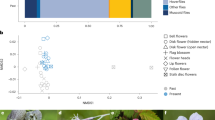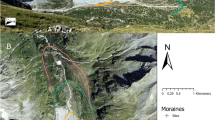Abstract
The continuing spread of exotic plants and increasing human land-use are two major drivers of global change threatening ecosystems, species and their interactions. Separate effects of these two drivers on plant–pollinator interactions have been thoroughly studied, but we still lack an understanding of combined and potential interactive effects. In a subtropical South African landscape, we studied 17 plant–pollinator networks along two gradients of relative abundance of exotics and land-use intensity. In general, pollinator visitation rates were lower on exotic plants than on native ones. Surprisingly, while visitation rates on native plants increased with relative abundance of exotics and land-use intensity, pollinator visitation on exotic plants decreased along the same gradients. There was a decrease in the specialization of plants on pollinators and vice versa with both drivers, regardless of plant origin. Decreases in pollinator specialization thereby seemed to be mediated by a species turnover towards habitat generalists. However, contrary to expectations, we detected no interactive effects between the two drivers. Our results suggest that exotic plants and land-use promote generalist plants and pollinators, while negatively affecting specialized plant–pollinator interactions. Weak integration and high specialization of exotic plants may have prevented interactive effects between exotic plants and land-use. Still, the additive effects of exotic plants and land-use on specialized plant–pollinator interactions would have been overlooked in a single-factor study. We therefore highlight the need to consider multiple drivers of global change in ecological research and conservation management.



Similar content being viewed by others
References
Aguilar R, Ashworth L, Galetto L, Aizen MA (2006) Plant reproductive susceptibility to habitat fragmentation: review and synthesis through a meta-analysis. Ecol Lett 9:968–980
Aizen MA, Morales CL, Morales JM (2008) Invasive mutualists erode native pollination webs. PLoS Biol 6:1–8
Aizen MA, Sabatino M, Tylianakis JM (2012) Specialization and rarity predict nonrandom loss of interactions from mutualist networks. Science 335:1486–1489
Albrecht M, Schmid B, Hautier Y, Müller CB (2012) Diverse pollinator communities enhance plant reproductive success. Proc R Soc B 279:4845–4852
Baayen RH (2011) languageR: data sets and functions with “Analyzing linguistic data: a practical introduction to statistics”. R package version 1.4
Bartomeus I, Vilà M, Steffan-Dewenter I (2010) Combined effects of Impatiens glandulifera invasion and landscape structure on native plant pollination. J Ecol 98:440–450
Bascompte J, Jordano P (2007) Plant-animal mutualistic networks: the architecture of biodiversity. Annu Rev Ecol Evol Syst 38:567–593
Bates D, Maechler M, Bolker B (2012) lme4: linear mixed-effects models using S4 classes: R package version 0.999999-0. Available at: http://cran.R-project.org/package=lme4.
Bernhardt P (1987) A comparison of the diversity, density, and foraging behavior of bees and wasps on Australian Acacia. Ann Mo Bot Gard 74:42–50
Biesmeijer JC, Roberts SPM, Reemer M, Ohlemüller R, Edwards M, Peeters T, Schaffers AP, Potts SG, Kleukers R, Thomas CD, Settele J, Kunin WE (2006) Parallel declines in pollinators and insect-pollinated plants in Britain and the Netherlands. Science 313:351–354
Bjerknes A-L, Totland Ø, Hegland SJ, Nielsen A (2007) Do alien plant invasions really affect pollination success in native plant species? Biol Conserv 138:1–12
Blanchet FG, Legendre P, Borcard D (2008) Forward selection of explanatory variables. Ecology 89:2623–2632
Blüthgen N (2010) Why network analysis is often disconnected from community ecology: a critique and an ecologist’s guide. Basic Appl Ecol 11:185–195
Blüthgen N, Menzel F, Blüthgen N (2006) Measuring specialization in species interaction networks. BMC Ecol 6:9
Bolker BM, Brooks ME, Clark CJ, Geange SW, Poulsen JR, Stevens MHH, White JSS (2009) Generalized linear mixed models: a practical guide for ecology and evolution. Trends Ecol Evol 24:127–135
Boon R (2010) Pooley’s trees of eastern South Africa, 2nd edn. Flora and Fauna Publications Trust, Durban
Borcard D, Legendre P (2002) All-scale spatial analysis of ecological data by means of principal coordinates of neighbour matrices. Ecol Model 153:51–68
Brosi BJ, Daily GC, Shih TM, Oviedo F, Durán G (2008) The effects of forest fragmentation on bee communities in tropical countryside. J Appl Ecol 45:773–783
Brückmann SV, Krauss J, Steffan-Dewenter I (2010) Butterfly and plant specialists suffer from reduced connectivity in fragmented landscapes. J Appl Ecol 47:799–809
Cairns CE, Villanueva-Gutiérrez R, Koptur S, Bray DB (2005) Bee populations, forest disturbance, and africanization in Mexico. Biotropica 37:686–692
Cooper KH (1985) The conservation status of indigenous forests in Transvaal, Natal and OFS, South Africa. Wildlife Society of Southern Africa, Durban
Dicks LV, Corbet SA, Pywell RF (2002) Compartmentalization in plant-insect flower visitor webs. J Anim Ecol 71:32–43
Didham RK, Tylianakis JM, Gemmell NJ, Rand TA, Ewers RM (2007) Interactive effects of habitat modification and species invasion on native species decline. Trends Ecol Evol 22:489–496
Dietzsch AC, Stanley DA, Stout JC (2011) Relative abundance of an invasive alien plant affects native pollination processes. Oecologia 167:469–479
Dormann CF, Fründ J, Blüthgen N, Gruber B (2009) Indices, graphs and null models: analyzing bipartite ecological networks. Open Ecol J 2:7–24
Dray S, Legendre P, Blanchet FG (2011) packfor: forward selection with permutation (Canoco p.46). R package version 0.0-8/r100. Available at: http://R-Forge.R-project.org/projects/sedar
Eeley HAC, Lawes MJ, Reyers B (2001) Priority areas for the conservation of subtropical indigenous forest in southern Africa: a case study from KwaZulu-Natal. Biodivers Conserv 10:1221–1246
Fontaine C, Dajoz I, Meriguet J, Loreau M (2006) Functional diversity of plant–pollinator interaction webs enhances the persistence of plant communities. PLoS Biol 4:e1. doi:10.1371/journal.pbio.0040001
Fontaine C, Collin CL, Dajoz I (2008) Generalist foraging of pollinators: diet expansion at high density. J Ecol 96:1002–1010
Ghazoul J (2004) Alien abduction: disruption of native plant–pollinator interactions by invasive species. Biotropica 36:156–164
Goulson D, Derwent LC (2004) Synergistic interactions between an exotic honeybee and an exotic weed: pollination of Lantana camara in Australia. Weed Res 44:195–202
Hagen M, Kraemer M (2010) Agricultural surroundings support flower–visitor networks in an afrotropical rain forest. Biol Conserv 143:1654–1663
Henderson L (2007) Invasive, naturalized and casual alien plants in southern Africa: a summary based on the Southern African Plant Invaders Atlas (SAPIA). Bothalia 37:215–248
Klein AM, Vaissière BE, Cane JH, Steffan-Dewenter I, Cunningham SA, Kremen C, Tscharntke T (2007) Importance of pollinators in changing landscapes for world crops. Proc R Soc B 274:303–313
Kremen C, Williams NM, Thorp RW (2002) Crop pollination from native bees at risk from agricultural intensification. Proc Natl Acad Sci USA 99:16812–16816
Lawes MJ (1990) The distribution of the samango monkey (Cercopithecus mitis erythrarchus Peters, 1852 and Cercopithecus mitis labiatus I. Geoffroy, 1843) and forest history in Southern Africa. J Biogeogr 17:669–680
Legendre P (1993) Spatial autocorrelation: trouble or new paradigm? Ecology 74:1659–1673
Legendre P, Gallagher ED (2001) Ecologically meaningful transformations for ordination of species data. Oecologia 129:271–280
MacArthur RH, Pianka ER (1966) On optimal use of a patchy environment. Am Nat 100:603–609
Memmott J, Waser NM (2002) Integration of alien plants into a native flower-pollinator visitation web. Proc R Soc B 269:2395–2399
Montero-Castaño A, Vilà M (2012) Impact of landscape alteration and invasions on pollinators: a meta-analysis. J Ecol 100:884–893
Moragues E, Traveset A (2005) Effect of Carpobrotus spp. on the pollination success of native plant species of the Balearic Islands. Biol Conserv 122:611–619
Morales CL, Traveset A (2009) A meta-analysis of impacts of alien vs. native plants on pollinator visitation and reproductive success of co-flowering native plants. Ecol Lett 12:716–728
Neuschulz EL, Grass I, Botzat A, Johnson SD, Farwig N (2013) Persistence of flower visitors and pollination services of a generalist tree in modified forests. Austral Ecol. doi:10.1111/j.1442-9993.2012.02417.x
Oksanen J, Blanchet FG, Kindt R, Legendre P, Minchin PR, O’Hara RB, Simpson GL, Solymos P, Stevens MHH, Wagner H (2011) vegan: community ecology package. R package version 2.0–2. Available at: http://vegan.r-forge.r-project.org/
Olesen JM, Eskildsen LI, Venkatasamy S (2002) Invasion of pollination networks on oceanic islands: importance of invader complexes and endemic super generalists. Divers Distrib 8:181–192
Ollerton J, Winfree R, Tarrant S (2011) How many flowering plants are pollinated by animals? Oikos 120:321–326
Pauw A, Hawkins JA (2011) Reconstruction of historic pollination rates reveals linked declines of pollinators and plants. Oikos 120:344–349
Picker M, Griffiths CL, Weaving A (2004) Field guide to insects of South Africa, 2nd edn. Struik, Cape Town
Pooley E (1998) A field guide to wild flowers: KwaZulu-Natal and the eastern region, 1st edn. Natal Flora Publications Trust, Durban
Potts SG, Biesmeijer JC, Kremen C, Neumann P, Schweiger O, Kunin WE (2010) Global pollinator declines: trends, impacts and drivers. Trends Ecol Evol 25:345–353
Pyšek P, Hulme PE (2005) Spatio-temporal dynamics of plant invasions: linking pattern to process. Ecoscience 12:302–315
R Development Core Team (2012) R: a language and environment for statistical computing. R Foundation for Statistical Computing, Vienna
Richardson DM, Pyšek P, Rejmánek M, Barbour MG, Panetta FD, West CJ (2000) Naturalization and invasion of alien plants: concepts and definitions. Divers Distrib 6:93–107
Sala OE, Chapin FS, Armesto JJ, Berlow E, Bloomfield J, Dirzo R,Huber-Sanwald E, Huenneke LF, Jackson RB, Kinzig A,Leemans R, Lodge DM, Mooney HA, Oesterheld M, Poff NL,Sykes MT, Walker BH, Walker M, Wall DH (2000) Global biodiversity scenarios for the year 2100. Science 287:1770–1774
Saunders DA, Hobbs RJ, Margules CR (1991) Biological consequences of ecosystem fragmentation: a review. Conserv Biol 5:18–32
Scholtz C, Holm E (2008) Insects of southern Africa, 2nd edn. Protea Boekhuis, Pretoria
Stang M, Klinkhamer PGL, Meijden EVD (2006) Size constraints and flower abundance determine the number of interactions in a plant-flower visitor web. Oikos 112:111–121
Steffan-Dewenter I, Münzenberg U, Bürger C, Thies C, Tscharntke T (2002) Scale-dependent effects of landscape context on three pollinator guilds. Ecology 83:1421–1432
Traveset A, Richardson DM (2006) Biological invasions as disruptors of plant reproductive mutualisms. Trends Ecol Evol 21:208–216
Tylianakis JM, Didham RK, Bascompte J, Wardle DA (2008) Global change and species interactions in terrestrial ecosystems. Ecol Lett 11:1351–1363
Tylianakis JM, Laliberté E, Nielsen A, Bascompte J (2010) Conservation of species interaction networks. Biol Conserv 143:2270–2279
Vázquez DP, Morris WF, Jordano P (2005) Interaction frequency as a surrogate for the total effect of animal mutualists on plants. Ecol Lett 8:1088–1094
Vilà M, Bartomeus I, Dietzsch AC, Petanidou T, Steffan-Dewenter I, Stout JC, Tscheulin T (2009) Invasive plant integration into native plant–pollinator networks across Europe. Proc R Soc B 276:3887–3893
von Maltitz G (2003) Classification system for South African indigenous forests: an objective classification for the Department of Water Affairs and Forestry. Environmentek report ENV-P-C 2003-017, CSIR, Pretoria
Ezemvelo KZN Wildlife (2011) KwaZulu-Natal land cover 2008 V1.1. Unpublished GIS coverage. Biodiversity Conservation Planning Division, Ezemvelo KZN Wildlife, Cascades, Pietermaritzburg
Williams NM, Cariveau D, Winfree R, Kremen C (2011) Bees in disturbed habitats use, but do not prefer, alien plants. Basic Appl Ecol 12:332–341
Winfree R, Griswold T, Kremen C (2007) Effect of human disturbance on bee communities in a forested ecosystem. Conserv Biol 21:213–223
Winfree R, Aguilar R, LeBuhn G (2009) A meta-analysis of bees’ responses to anthropogenic disturbance. Ecology 90:2068–2076
Woodhall S (2005) Field guide to butterflies of South Africa, 1st edn. Struik, Cape Town
Zurbuchen A, Landert L, Klaiber J, Müller A, Hein S, Dorn S (2010) Maximum foraging ranges in solitary bees: only few individuals have the capability to cover long foraging distances. Biol Conserv 143:669–676
Acknowledgments
We thank Ezemvelo KZN Wildlife for permission to work within the Oribi Gorge Nature Reserve, and all South African farmers who granted us access to their land. We are grateful to S.-L. Steenhuisen and S. Johnson for providing advice and field equipment, and to H. and M. Neethling, P. Pillay and F. Voigt for their manifold support. We thank J. Albrecht for valuable discussions on the statistical analyses, and R. Brandl, K. Fiedler and two anonymous reviewers for insightful comments that substantially improved the manuscript. Funding was provided by the Robert Bosch Stiftung. Field work complied with the current laws of the Republic of South Africa.
Author information
Authors and Affiliations
Corresponding author
Additional information
Communicated by Roland Brandl.
Electronic supplementary material
Below is the link to the electronic supplementary material.
Rights and permissions
About this article
Cite this article
Grass, I., Berens, D.G., Peter, F. et al. Additive effects of exotic plant abundance and land-use intensity on plant–pollinator interactions. Oecologia 173, 913–923 (2013). https://doi.org/10.1007/s00442-013-2688-6
Received:
Accepted:
Published:
Issue Date:
DOI: https://doi.org/10.1007/s00442-013-2688-6




